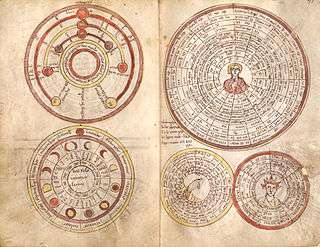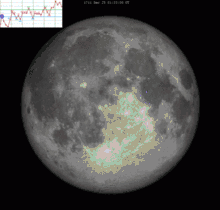Metonic cycle
The Metonic cycle or enneadecaeteris (from Ancient Greek: ἐννεακαιδεκαετηρίς (enneakaidekaeteris), "nineteen") is a period of approximately 19 years after which the phases of the moon recur on the same day of the year. The recurrence is not perfect, and by precise observation the Metonic cycle is defined as 235 synodic lunar months, a period which is just 1h27m33s longer than 19 tropical years. Using these integer numbers facilitates the construction of a luni-solar calendar.


A tropical year is longer than 12 lunar months and shorter than 13 of them. The arithmetical equality
12x12 + 7x13 = 235
allows it to be seen that a combination of 12 'shorter' (12 months) years and 7 'longer' (13 months) years will be equal to 19=12+7 solar years.
Application in traditional calendars
Traditionally, for the Babylonian and Hebrew lunisolar calendars, the years 3, 6, 8, 11, 14, 17, and 19 are the long (13-month) years of the Metonic cycle. This cycle forms the basis of the Greek and Hebrew calendars, and is used for the computation of the date of Easter each year.
The Babylonians applied the 19-year cycle since the late sixth century BC.[3] As they measured the moon's motion against the stars, the 235:19 relationship may originally have referred to sidereal years, instead of tropical years as it has been used for various calendars.
According to Livy, the king of Rome Numa Pompilius (753–673 BC) inserted intercalary months in such a way that "in the twentieth year the days should fall in with the same position of the sun from which they had started."[4] As "the twentieth year" takes place nineteen years after "the first year", this seems to indicate that the Metonic cycle was applied to Numa's calendar.
Diodorus Siculus reports that Apollo is said to have visited the Hyperboreans once every 19 years.[5]
The Metonic cycle has been implemented in the Antikythera mechanism which offers unexpected evidence for the popularity of the calendar based on it.[6] Meton of Athens approximated the cycle to a whole number (6,940) of days, obtained by 125 long months of 30 days and 110 short months of 29 days. During the next century, Callippus developed the Callippic cycle of four 19-year periods for a 76-year cycle with a mean year of exactly 365.25 days.
The (19-year) Metonic cycle is a lunisolar cycle, as is the (76-year) Callippic cycle.[7] An important example of an application of the Metonic cycle in the Julian calendar is the 19-year lunar cycle insofar as provided with a Metonic structure.[8] Around AD 260 the Alexandrian computist Anatolius, who became bishop of Laodicea in AD 268, was the first to construct a version of this efficient computistical instrument for determining the date of Easter Sunday.[9] However, it was some later, somewhat different, version of the Metonic 19-year lunar cycle which ultimately, as the basic structure of Dionysius Exiguus’ and also of Bede’s Easter table, would prevail throughout Christendom for a long time,[10] at least until in the year 1582, when the Julian calendar was replaced with the Gregorian calendar.
The Runic calendar is a perpetual calendar based on the 19-year-long Metonic cycle. Also known as a Rune staff or Runic Almanac, it appears to have been a medieval Swedish invention. This calendar does not rely on knowledge of the duration of the tropical year or of the occurrence of leap years. It is set at the beginning of each year by observing the first full moon after the winter solstice. The oldest one known, and the only one from the Middle Ages, is the Nyköping staff, which is believed to date from the 13th century.
The Bahá'í calendar, established during the middle of the 19th century, is also based on cycles of 19 years.
In China, the traditional Chinese calendar used the Metonic cycle ever since the first known ancient China calendar. The cycle was continually used until the 5th century when it was replaced by a more accurate cycle.[11]
Mathematical basis
The importance of the tropical year for agriculture came to be realized much later than the adoption of lunar months for time keeping. However, it was recognized that the two cannot be easily coordinated over a short time span, so longer intervals were considered and the Metonic cycle was discovered as rather good, but not perfect, schema. The currently accepted values are:
- 235 synodic months (lunar phases) = 6,939.688 days (Metonic period by definition).
- 19 tropical years = 6,939.602 days
The difference is 0.086 days for a cycle which mean that after a dozen returns there will be a full day of delay between the astronomical data and calculations. The error is actually one day every 219 years, or 12.4 parts per million. However, the Metonic cycle turned out to be very close to other periods:
- 254 sidereal months (lunar orbits) = 6,939.702 days
- 255 draconic months (lunar nodes) = 6,939.1161 days.
- 20.021 eclipse years (40 eclipse seasons)
Being close (to somewhat more than half a day) to 255 draconic months, the Metonic cycle is also an eclipse cycle, which lasts only for about 4 or 5 recurrences of eclipses. The Octon is 1⁄5 of a Metonic cycle (47 synodic months, 3.8 years), and it recurs about 20 to 25 cycles.
This cycle seems to be a coincidence. The periods of the Moon's orbit around the Earth and the Earth's orbit around the Sun are believed to be independent, and not to have any known physical resonance. An example of a non-coincidental cycle is the orbit of Mercury, with its 3:2 spin-orbit resonance.
A lunar year of 12 synodic months is about 354 days, approximately 11 days short of the "365-day" solar year. Therefore, for a lunisolar calendar, every 2 to 3 years there is a difference of more than a full lunar month between the lunar and solar years, and an extra (embolismic) month needs to be inserted (intercalation). The Athenians initially seem not to have had a regular means of intercalating a 13th month; instead, the question of when to add a month was decided by an official. Meton's discovery made it possible to propose a regular intercalation scheme. The Babylonians seem to have introduced this scheme around 500 BC, thus well before Meton.
Further details
The Metonic cycle is related to two less accurate subcycles:
- 8 years = 99 lunations (an Octaeteris) to within 1.5 days, i.e. an error of one day in 5 years; and
- 11 years = 136 lunations within 1.5 days, i.e. an error of one day in 7.3 years.
By combining appropriate numbers of 11-year and 19-year periods, it is possible to generate ever more accurate cycles. For example, simple arithmetic shows that:
- 687 tropical years = 250,921.39 days;
- 8,497 lunations = 250,921.41 days.
This gives an error of only about half an hour in 687 years (2.5 seconds a year), although this is subject to secular variation in the length of the tropical year and the lunation.
At the time of Meton, axial precession had not yet been discovered, and he could not distinguish between sidereal years (currently: 365.256363 days) and tropical years (currently: 365.242190 days). Most calendars, like the commonly used Gregorian calendar, are based on the tropical year and maintain the seasons at the same calendar times each year.
See also
- Octaeteris (8-year cycle of antiquity)
- Callippic cycle (76-year cycle from 330 BC)
- Hipparchic cycle (304-year cycle from 2nd century BC)
- Saros cycle of eclipses
- Attic and Byzantine calendar
- Chinese calendar
- Hebrew calendar
- Runic calendar
- Julian day
Notes
- Rare Full Moon on Christmas Day, NASA
- Ask Tom: How unusual is a full moon on Christmas Day?
- "The Babylonian Calendar".
- Livy, Ab Urbe Condita, I, XIX, 6.
- Diodorus Siculus, Bibl. Hist. II.47.
- Freeth, Tony; Jones, Alexander; Steele, John M.; Bitsakis, Yanis (31 July 2008). "Calendars with Olympiad display and eclipse prediction on the Antikythera Mechanism" (PDF). Nature. 454 (7204): 614–7. Bibcode:2008Natur.454..614F. doi:10.1038/nature07130. PMID 18668103. Retrieved 20 May 2014.
- Nothaft (2012) 168
- Mc Carthy & Breen (2003) 17
- Declecq (2000) 65-66
- Declercq (2000) 66
- 瞿曇悉達. "《古今历积年及章率》". 開元占經 (in Chinese). 第105卷.
References
- Mathematical Astronomy Morsels, Jean Meeus, Willmann-Bell, Inc., 1997 (Chapter 9, p. 51, Table 9. A Some eclipse Periodicities)
- C. Philipp E. Nothaft (2012) Dating the Passion (The Life of Jesus and the Emergence of Scientific Chronology (200-1600), Leiden ISBN 9789004212190)
- Daniel P. Mc Carthy & Aidan Breen (2003) The ante-Nicene Christian Pasch De ratione paschali (The Paschal tract of Anatolius, bishop of Laodicea): Dublin (ISBN 9781851826971)
- Georges Declercq (2000) Anno Domini (The Origins of the Christian Era): Turnhout (ISBN 9782503510507)